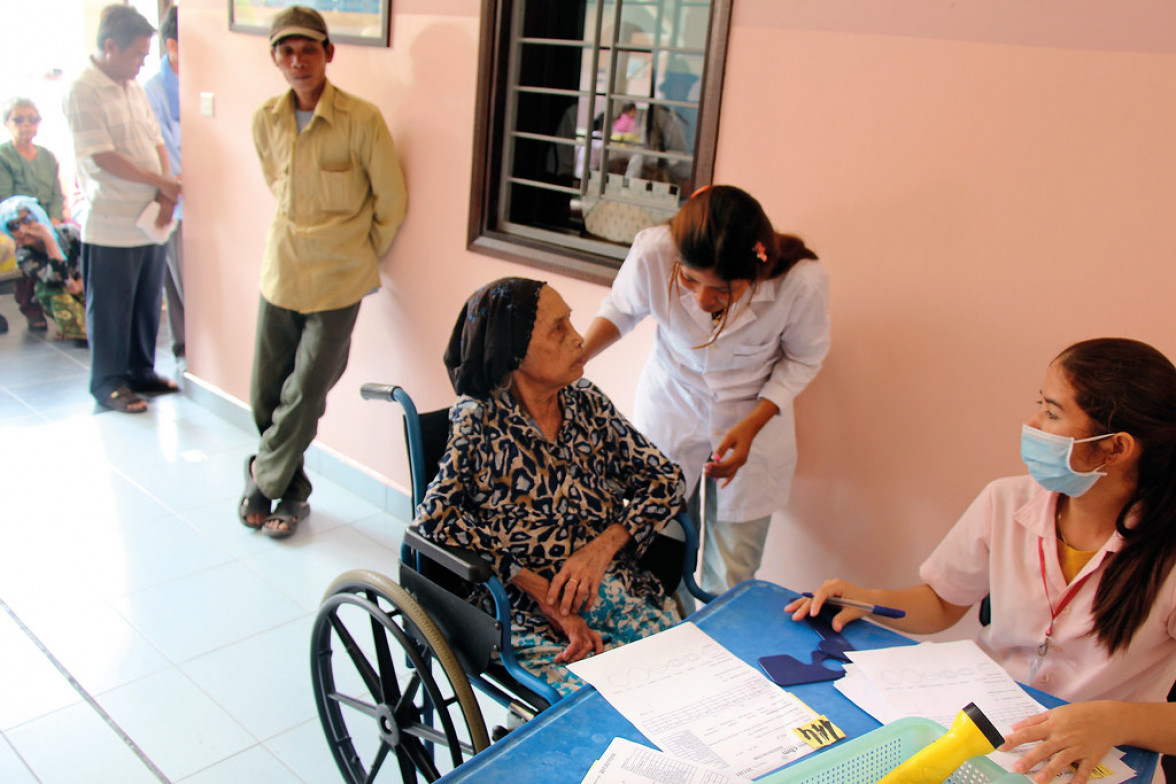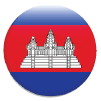
Free COVID-19 Treatment: A Path Toward Universal Health Coverage in Cambodia

Written by: Ly Houv, a 4th year student majoring in International Studies at The Royal University of Phnom Penh
Edited by: Sao Phal Niseiy, Editor-in-Chief at The Cambodianess and Deputy Editor-in-Chief at Thmey Thmey News

(Photo Credit: "Better physical accessibility and greater awareness of disability by hospital staff have improved the inclusion of people with impairments. CAMBODIA" by Community Eye Health is licensed under CC BY-NC 2.0)
For the majority of Cambodians, it is common sense that the healthcare service is costly and inefficient. If they can afford high-cost health services provided by private hospitals or clinics in the country, they might be lucky. They might be even more fortunate if they can afford to receive health treatment abroad.
Unfortunately, most Cambodians cannot afford such services when they are sick or get into accidents. Even though the Cambodian government has been trying hard to push forward and follow the Universal Health Coverage (UHC) based on the World Health Organization (WHO) program, there are numerous challenges to achieve it.
Universal Health Coverage is an important mechanism introduced by the World Health Organization (WHO) to address the inequality and the healthcare problem and promote better health and well-being of people. UHC, by definition, refers to a situation in which all people can obtain the healthcare they need without facing financial hardship. Furthermore, the WHO also claims that UHC in Cambodia is “a success in the making and the unfinished agenda”.
In 2016, the Cambodian government issued the Health Insurance Scheme under the National Social Security Fund (NSSF), which covers health care for workers. When they are sick, under the NSSF contracts, they do not need to pay for health treatment at public or private hospitals. Moreover, as a part of social protection policy, the government also unveiled the Identification of Poor Households (ID-Poor) program known as a poverty card to support deprived families. Those who are holding ID-Poor cards can access free treatment at public hospitals. When it comes to the ID-Poor program, there are problems and challenges such as poor quality and inefficient services provided by healthcare workers. There are also irregularities and nepotism reported in the process of issuing the cards. This malpractice has led to a condition in which truly needy households do not receive assistance. As a result, they have no choice but to force themselves to spend money on healthcare services.
According to the Cambodia National Health Accounts (2012-2016), the government expenditure on health was only 22.3%, while the out-of-pocket spending of Cambodians accounted for 60.4%. It indicates that the health financing allowed by the government was minimal, not enough to support the entire basic healthcare system.
The Ministry of Health (MOH)'s Annual Health Financing Report 2015 showed that more than 10,000 people in Cambodia struggled to pay the high medical bills and even fell into debt. Dr. Monoe Takeuchi, WHO in Cambodia's Acting Health systems Team Leader, said: “The risk of being pushed into poverty by health care expenditure is not low in Cambodia". The report added that most of them were vulnerable populations such as the poor, migrants, the elderly, disabled people, ethnic minorities, rural residents, mothers, and children. Therefore, people are afraid of being sick because what worries them the most is the skyrocketing healthcare cost.
However, the COVID-19 pandemic has set a new challenge for the healthcare capability and responsibility of Cambodia. Since the first COVID-19 case was identified in January 2020, we could see that the government has been trying to contain community transmission by setting rules and regulations for the incoming travelers while providing all Cambodians free-of-charge testing service and treatment. By mentioning this, the responsibility and accountability of the government somehow make people feel confident and safe.
They generally can be less concerned about bearing hefty medical bills if they get infected. Either wealthy or poor patients receive the same healthcare, for example, staying at the same medical centers and taking the same medication. Most importantly, on the third community transmission known as the February 20 community event, the new wave of infections has enormously challenged the country's public health system. As hospitals have been overwhelmed with skyrocketing new cases, many sites are turned into quarantine centers and treatment centers. The treatment, of course, is still free of charge, but the government also decided to greenlight private hospitals to treat COVID patients as they need to bear treatment costs.
Taking this into account, this is a positive sign that Cambodians can receive the first-ever free and fair healthcare services, although it is only specifically for the COVID-19 case.
What does this mean for the future of Cambodia's commitment to achieving UHC?
It is difficult to predict what the future may hold since the pandemic is far from over, and whether the government will continue to cover the costs remains unclear. However, the COVID-19 policy designed by the government has satisfied the people, and the public trust in health care services administered by the government appears to be growing.
The Cambodian government has been trying hard and working closely with the WHO to achieve this universal healthcare.
As seen, the National Social Protection Policy Framework 2016-2025 has been endorsed by the government. It provides a vision for future development and governance of the country’s social protection system, such as the UHC’s roadmap. The roadmap consists of a social health insurance scheme for formal private employees and public employees run by NSSF, the Health Equity Fund (HEF) coverage for poor and other vulnerable groups with the ID-Poor program, and health insurance for informal sector employees.
Yet, there are many obstacles for the country to achieve this ambitious goal. Firstly, given that the general quality of public health services has increased over the past years, there remain many issues, including the in-patient treatment services, which are generally lower than patients' expectations. There have still been insufficient health facilities and advanced medical equipment. Also, the delivery of healthcare services is ineffective and inadequate as a small number of medical workers do not put enough effort into their duties. That also includes an impolite or disrespectful manner to the patients who use the insurance program or the ID-Poor card.
Thus, there necessitate further improvements in the public health system in which regulatory mechanisms need strengthening. Meanwhile, more capacity building for medical staff with an expansion of healthcare facilities is also necessary. Secondly, another most challenging issue facing Cambodia is its limited financial capability.
In 2018, the health expenditure per capita, PPP (in USD) was only $261, which means that each Cambodian spent $261 on healthcare on average. Meanwhile, in Thailand and Vietnam, the healthcare expenses per person in 2018 were $722 and $440, respectively. It’s double and triple the amount of money spent by a Cambodian. More than this, the out-of-pocket spending in 2018 on healthcare accounted for 57%, whereas that of Thailand and Vietnam was 11% and 44%.
In Cambodia, there are commonly three health financing sources. These include the government budget, development assistance provided by donors as well as out-of-pocket payments. So far, the public funding allocated to the healthcare sector has only shared around 18.5% of the total expenditure. So, it can indicate that achieving the UHC in Cambodia is pretty challenging with the limited resources. Consequently, the government should mull on injecting more investment into the health sector. It means the government needs to generate more revenues, and there are available options such as hiking tobacco and alcohol taxes.
Thirdly, the operating system also plays a vital role in encouraging further reform of the healthcare system in Cambodia. For instance, there should be more transparency in the tax revenue collection, revenues generated through the NSSF and the expenditure. These types of information should be publicly available for everyone. The claiming procedure of NSSF, ID-Poor program and health insurance should be more effective and less complicated as the current system requires manual processing with several steps in claiming the insurance benefits. Notably, up to 50,000 individual claims per month create more burden for insurance staff, and it does not benefit the patients either.
Generally, a free or at least affordable healthcare service can still be established in a time of public health crises like the COVID-19 pandemic as long as there is trust and the support of the people. Through its current efforts, the MOH has built a good reputation and integrity, and it may add up the courage to do more in improving its works and push for a realization of the UHC.
A good public healthcare system is always an essential contribution to the sustainable development of Cambodia as a developing country. It is undeniable that when good healthcare services are delivered, the labor force and human resources, who are the backbone of growth, can also become healthier.
All in all, I believe that instead of considering the COVID-19 pandemic as a public health curse, we should regard it as a time for a reflection on our existing healthcare policy and make changes for good. That means we can transform it into a blessing and work together to put a better emphasis on the advancement of our health sector. Once our public health system is progressed, becoming more efficient and responsive with everyone able to access it equally and affordably, we can build a more inclusive and sustainable future for all.
*This blog is produced with the financial support from the European Union and The Swedish International Development Cooperation Agency through Transparency International Cambodia and ActionAid Cambodia. Its contents do not reflect the views of any donors.




